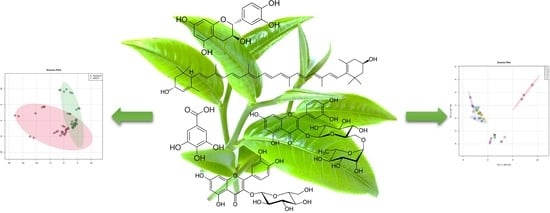Phenolic, Carotenoid and Saccharide Compositions of Vietnamese Camellia sinensis Teas and Herbal Teas
Abstract
:1. Introduction
2. Materials and Methods
2.1. Chemicals and Reagents
2.2. Tea Samples
2.3. Analysis of Phenolics
2.4. Analysis of Carotenoids
2.5. Analysis of Saccharides
2.6. Statistical Analyses
3. Results and Discussion
3.1. Phenolic Contents in the Teas and Herbal Teas
3.2. Flavonoids
3.3. Phenolic Acids
3.4. Comparison between Solvent Extraction Methods
3.5. Carotenoid Composition of the Teas
3.6. Saccharides in the Teas
3.7. Compositional Variations of the Teas
4. Conclusions
Supplementary Materials
Author Contributions
Funding
Institutional Review Board Statement
Informed Consent Statement
Data Availability Statement
Conflicts of Interest
References
- Hayat, K.; Iqbal, H.; Malik, U.; Bilal, U.; Mushtaq, S. Tea and its consumption: Benefits and risks. Crit. Rev. Food Sci. Nutr. 2015, 55, 939–954. [Google Scholar] [CrossRef]
- Agati, G.; Azzarello, E.; Pollastri, S.; Tattini, M. Flavonoids as antioxidants in plants: Location and functional significance. Plant. Sci. 2012, 196, 67–76. [Google Scholar] [CrossRef] [PubMed]
- Li, W.; He, N.; Tian, L.; Shi, X.; Yang, X. Inhibitory effects of polyphenol-enriched extract from Ziyang tea against human breast cancer MCF-7 cells through reactive oxygen species-dependent mitochondria molecular mechanism. J. Food Drug Anal. 2016, 24, 527–538. [Google Scholar] [CrossRef] [PubMed] [Green Version]
- Yang, C.S.; Wang, H. Cancer preventive activities of tea catechins. Molecules 2016, 21, 1679. [Google Scholar] [CrossRef]
- Yang, C.S.; Wang, H.; Sheridan, Z.P. Studies on prevention of obesity, metabolic syndrome, diabetes, cardiovascular diseases and cancer by tea. J. Food Drug Anal. 2018, 26, 1–13. [Google Scholar] [CrossRef] [Green Version]
- Liu, Z.; Zhou, T.; Ziegler, A.C.; Dimitrion, P.; Zuo, L. Oxidative stress in neurodegenerative diseases: From molecular mechanisms to clinical applications. Oxid. Med. Cell. Longev. 2017, 2017. [Google Scholar] [CrossRef]
- Chacko, S.M.; Thambi, P.T.; Kuttan, R.; Nishigaki, I. Beneficial effects of green tea: A literature review. Chinese Med. 2010, 5, 13. [Google Scholar] [CrossRef] [PubMed] [Green Version]
- Ho, C.-T.; Zheng, X.; Li, S. Tea aroma formation. Food Sci. Hum. Wellness 2015, 4, 9–27. [Google Scholar] [CrossRef] [Green Version]
- Stahl, W.; Sies, H. Bioactivity and protective effects of natural carotenoids. Biochim. Biophys. Acta Mol. Basis Dis. 2005, 1740, 101–107. [Google Scholar] [CrossRef] [Green Version]
- Wang, Y.; Yang, Z.; Wei, X. Sugar compositions, α-glucosidase inhibitory and amylase inhibitory activities of polysaccharides from leaves and flowers of Camellia sinensis obtained by different extraction methods. Int. J. Biol. Macromol. 2010, 47, 534–539. [Google Scholar] [CrossRef]
- Hidalgo-Cantabrana, C.; Delgado, S.; Ruiz, L.; Ruas-Madiedo, P.; Sánchez, B.; Margolles, A. Bifidobacteria and their health-promoting effects. Microbiol. Spectr. 2017, 5, 21. [Google Scholar] [CrossRef]
- Khoi, N.V.; Lan, C.H.; Huong, T.L. Vietnam tea industry-an analysis from value chain approach. Int. J. Manag. Value Supply Chain. 2015, 6, 1–14. [Google Scholar] [CrossRef]
- Tuan, N.-A. Vietnamese Tea Exporting and Forecasting to 2030. Vietnam. J. Agric. Sci. 2020, 3, 636–646. [Google Scholar]
- Vuong, Q.V.; Nguyen, V.; Golding, J.B.; Roach, P.D. The content of bioactive constituents as a quality index for Vietnamese teas. Int. Food Res. J. 2011, 18, 329–336. [Google Scholar]
- Nguyen, C.T.; Lee, A.H.; Pham, N.M.; Do, V.V.; Ngu, N.D.; Tran, B.Q.; Binns, C. Habitual tea drinking associated with a lower risk of type 2 diabetes in Vietnamese adults. Asia Pac. J. Clin. Nutr. 2018, 27, 701. [Google Scholar] [PubMed]
- Van Dong Hoang, A.H.L.; Pham, N.M.; Xu, D.; Binns, C.W. Habitual tea consumption reduces prostate cancer risk in Vietnamese Men: A case-control study. Asian Pac. J. Cancer Prev. 2016, 17, 4939. [Google Scholar]
- Dautermann, O.; Lohr, M. A functional zeaxanthin epoxidase from red algae shedding light on the evolution of light-harvesting carotenoids and the xanthophyll cycle in photosynthetic eukaryotes. Plant J. 2017, 92, 879–891. [Google Scholar] [CrossRef] [PubMed]
- Chong, J.; Soufan, O.; Li, C.; Caraus, I.; Li, S.; Bourque, G.; Wishart, D.S.; Xia, J. MetaboAnalyst 4.0: Towards more transparent and integrative metabolomics analysis. Nucleic Acids Res. 2018, 46, W486–W494. [Google Scholar] [CrossRef] [Green Version]
- Yang, J.; Liu, R.H. The phenolic profiles and antioxidant activity in different types of tea. Int. J. Food Sci. Technol. 2013, 48, 163–171. [Google Scholar] [CrossRef]
- Muhammad, H.F.L.; Dickinson, K.M. Nutrients, Energy Values and Health Impact of Conventional Beverages, 1st ed.; Elsevier: Amsterdam, The Netherlands, 2019; pp. 41–75. [Google Scholar]
- Jeszka-Skowron, M.; Zgoła-Grześkowiak, A.; Frankowski, R. Cistus incanus a promising herbal tea rich in bioactive compounds: LC–MS/MS Determination of catechins, flavonols, phenolic acids and alkaloids—A comparison with Camellia sinensis, Rooibos and Hoan ngoc herbal tea. J. Food Compos. Anal. 2018, 74, 71–81. [Google Scholar] [CrossRef]
- Jiang, H.; Yu, F.; Qin, L.; Zhang, N.; Cao, Q.; Schwab, W.; Li, D.; Song, C. Dynamic change in amino acids, catechins, alkaloids, and gallic acid in six types of tea processed from the same batch of fresh tea (Camellia sinensis L.) leaves. J. Food Compos. Anal. 2019, 77, 28–38. [Google Scholar] [CrossRef]
- Pinto, G.; Illiano, A.; Carpentieri, A.; Spinelli, M.; Melchiorre, C.; Fontanarosa, C.; Serio, M.d.; Amoresano, A. Quantification of polyphenols and metals in Chinese tea infusions by mass spectrometry. Foods 2020, 9, 835. [Google Scholar] [CrossRef] [PubMed]
- Dai, W.; Xie, D.; Lu, M.; Li, P.; Lv, H.; Yang, C.; Peng, Q.; Zhu, Y.; Guo, L.; Zhang, Y. Characterization of white tea metabolome: Comparison against green and black tea by a nontargeted metabolomics approach. Food Res. Int. 2017, 96, 40–45. [Google Scholar] [CrossRef] [PubMed]
- Wu, C.; Xu, H.; Héritier, J.; Andlauer, W. Determination of catechins and flavonol glycosides in Chinese tea varieties. Food Chem. 2012, 132, 144–149. [Google Scholar] [CrossRef]
- Jiang, H.; Engelhardt, U.H.; Thräne, C.; Maiwald, B.; Stark, J. Determination of flavonol glycosides in green tea, oolong tea and black tea by UHPLC compared to HPLC. Food Chem. 2015, 183, 30–35. [Google Scholar] [CrossRef]
- Tan, J.; Dai, W.; Lu, M.; Lv, H.; Guo, L.; Zhang, Y.; Zhu, Y.; Peng, Q.; Lin, Z. Study of the dynamic changes in the non-volatile chemical constituents of black tea during fermentation processing by a non-targeted metabolomics approach. Food Res. Int. 2016, 79, 106–113. [Google Scholar] [CrossRef]
- Zeng, C.; Lin, H.; Liu, Z.; Liu, Z. Metabolomics analysis of Camellia sinensis with respect to harvesting time. Food Res. Int. 2020, 128, 108814. [Google Scholar] [CrossRef] [PubMed]
- Ramakrishnan, P.; Rangiah, K. A UHPLC-MS/SRM method for analysis of phenolics from Camellia sinensis leaves from Nilgiri hills. Anal. Methods 2016, 8, 8033–8041. [Google Scholar] [CrossRef]
- Konieczynski, P.; Viapiana, A.; Wesolowski, M. Comparison of infusions from black and green teas (Camellia sinensis L. Kuntze) and erva-mate (Ilex paraguariensis A. St.-Hil.) based on the content of essential elements, secondary metabolites, and antioxidant activity. Food Anal. Methods 2017, 10, 3063–3070. [Google Scholar] [CrossRef] [Green Version]
- Su, X.; Wang, W.; Xia, T.; Gao, L.; Shen, G.; Pang, Y. Characterization of a heat responsive UDP: Flavonoid glucosyltransferase gene in tea plant (Camellia sinensis). PLoS ONE 2018, 13, 207–212. [Google Scholar] [CrossRef]
- Sa, R.R.; Matos, R.A.; Silva, V.C.; da Cruz Caldas, J.; da Silva Sauthier, M.C.; dos Santos, W.N.L.; Magalhães, H.I.F.; Júnior, A.d.F.S. Determination of bioactive phenolics in herbal medicines containing Cynara scolymus, Maytenus ilicifolia Mart ex Reiss and Ptychopetalum uncinatum by HPLC-DAD. Microchem. J. 2017, 135, 10–15. [Google Scholar] [CrossRef]
- Chen, G.-L.; Chen, S.-G.; Xiao, Y.; Fu, N.-L. Antioxidant capacities and total phenolic contents of 30 flowers. Ind. Crops Prod. 2018, 111, 430–445. [Google Scholar] [CrossRef]
- Bae, I.K.; Ham, H.M.; Jeong, M.H.; Kim, D.H.; Kim, H.J. Simultaneous determination of 15 phenolic compounds and caffeine in teas and mate using RP-HPLC/UV detection: Method development and optimization of extraction process. Food Chem. 2015, 172, 469–475. [Google Scholar] [CrossRef] [PubMed]
- Anand, J.; Upadhyaya, B.; Rawat, P.; Rai, N. Biochemical characterization and pharmacognostic evaluation of purified catechins in green tea (Camellia sinensis) cultivars of India. 3 Biotech 2015, 5, 285–294. [Google Scholar] [CrossRef] [Green Version]
- Barreira, S.; Moutinho, C.; Silva, A.M.N.; Neves, J.; Seo, E.-J.; Hegazy, M.-E.F.; Efferth, T.; Gomes, L.R. Phytochemical characterization and biological activities of green tea (Camellia sinensis) produced in the Azores, Portugal. Phytomedicine Plus 2021, 1, 100001. [Google Scholar] [CrossRef]
- Loranty, A.; Rembiałkowska, E.; Rosa, E.A.S.; Bennett, R.N. Identification, quantification and availability of carotenoids and chlorophylls in fruit, herb and medicinal teas. J. Food Compos. Anal. 2010, 23, 432–441. [Google Scholar] [CrossRef]
- Ravichandran, R. Carotenoid composition, distribution and degradation to flavour volatiles during black tea manufacture and the effect of carotenoid supplementation on tea quality and aroma. Food Chem. 2002, 78, 23–28. [Google Scholar] [CrossRef]
- Suzuki, Y.; Shioi, Y. Identification of chlorophylls and carotenoids in major teas by high-performance liquid chromatography with photodiode array detection. J. Agric. Food Chem. 2003, 51, 5307–5314. [Google Scholar] [CrossRef]
- Stuetz, W.; Schlörmann, W.; Glei, M. B-vitamins, carotenoids and α-/γ-tocopherol in raw and roasted nuts. Food Chem. 2017, 221, 222–227. [Google Scholar] [CrossRef]
- Tanaka, T.; Shnimizu, M.; Moriwaki, H. Cancer chemoprevention by carotenoids. Molecules 2012, 17, 3202–3242. [Google Scholar] [CrossRef]
- Shanmugavelan, P.; Kim, S.Y.; Kim, J.B.; Kim, H.W.; Cho, S.M.; Kim, S.N.; Kim, S.Y.; Cho, Y.S.; Kim, H.R. Evaluation of sugar content and composition in commonly consumed Korean vegetables, fruits, cereals, seed plants, and leaves by HPLC-ELSD. Carbohydr. Res. 2013, 380, 112–117. [Google Scholar] [CrossRef] [PubMed]
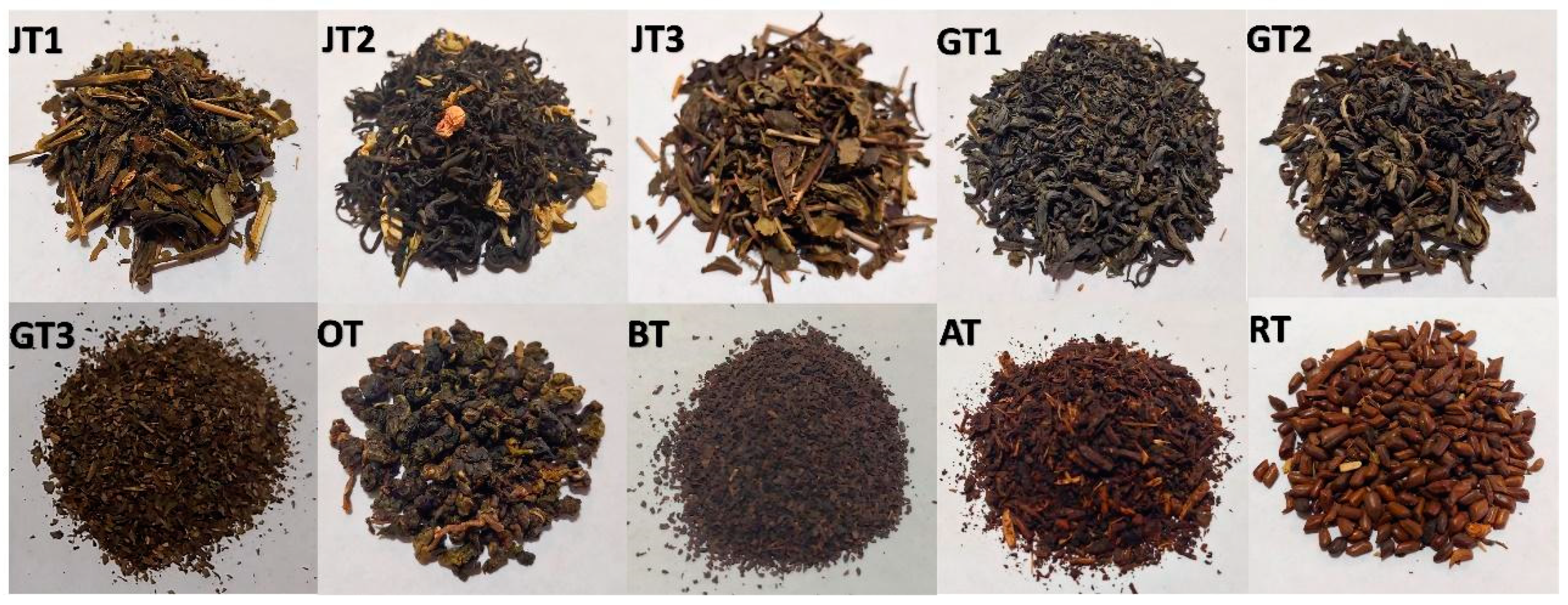
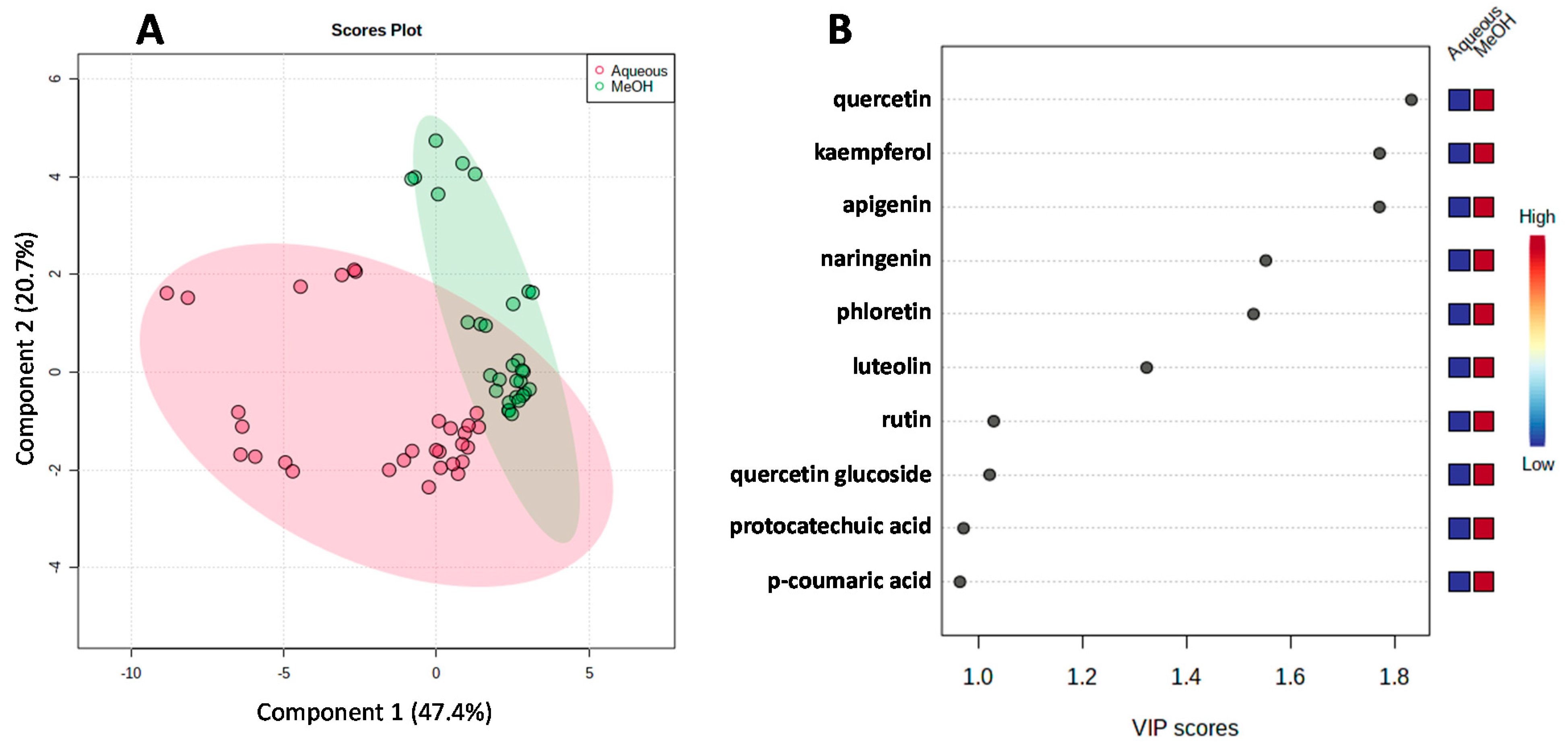
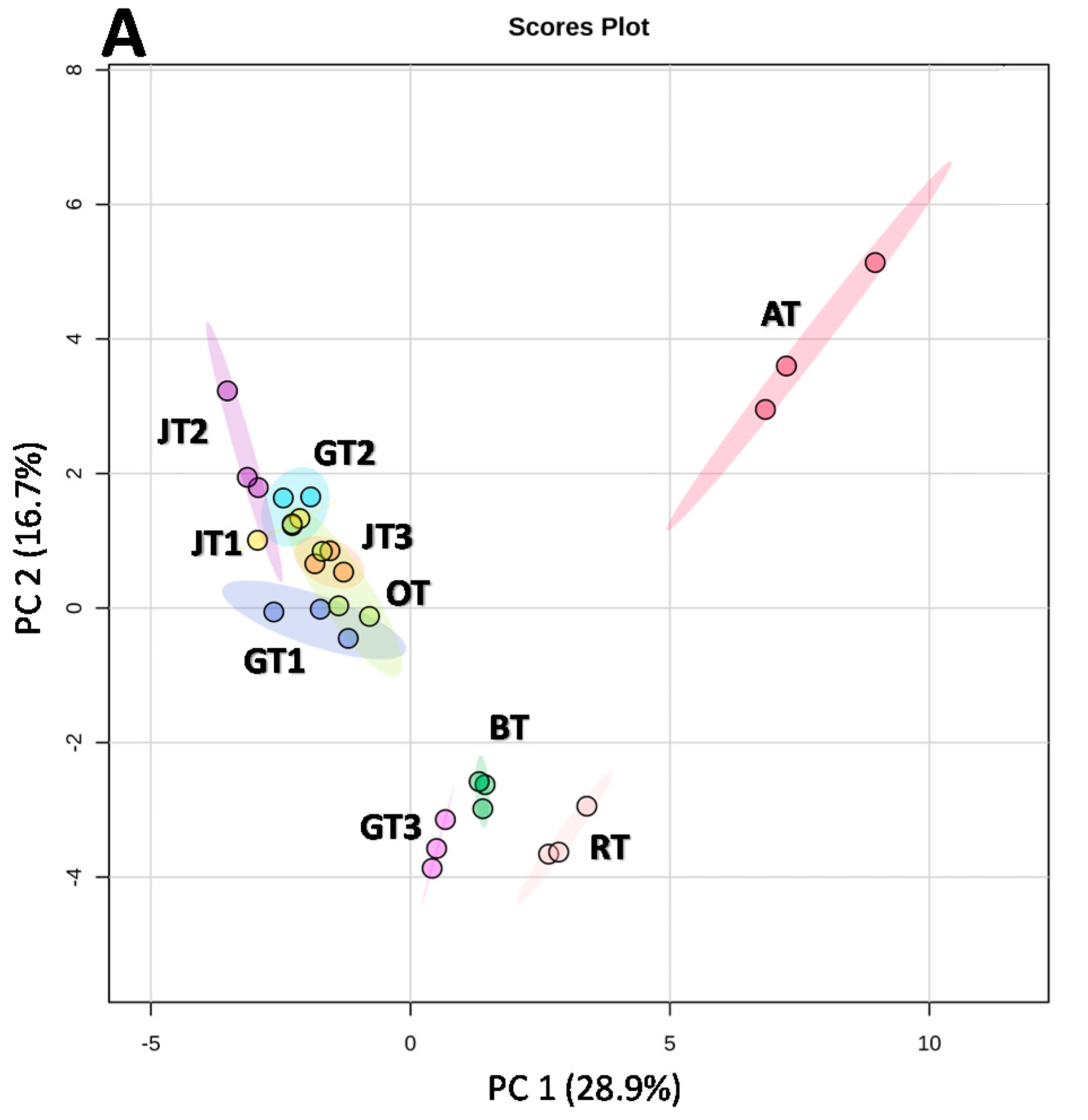
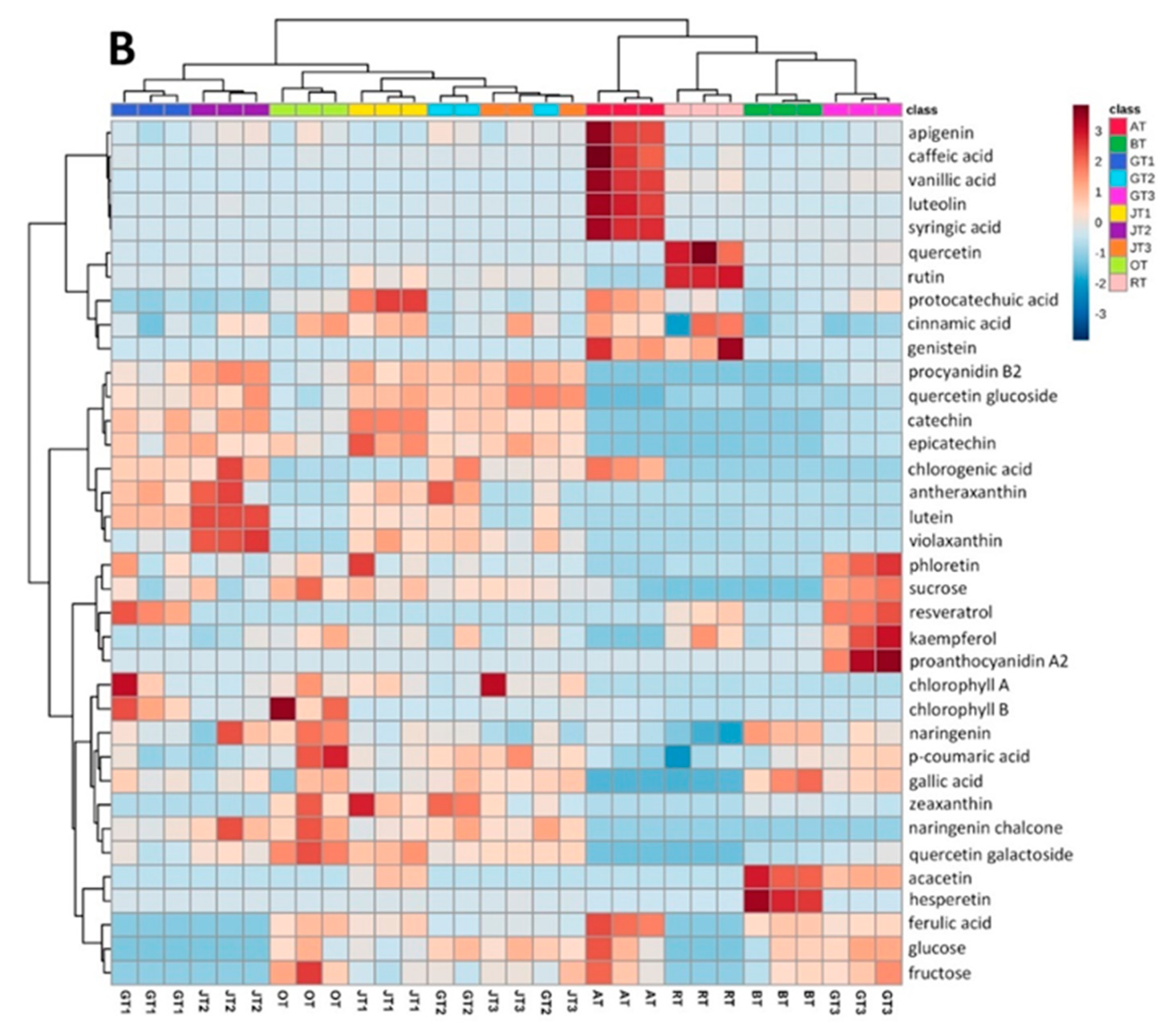
| Abbreviations | Vietnamese Name | Packaging | Purchase Location | Origin | |
|---|---|---|---|---|---|
| Jasmine tea 1 | JT1 | trà lài | loose tea | Vietnam | Lam Dong, Vietnam |
| Jasmine tea 2 | JT2 | loose tea | Vietnam | Thai Nguyen, Vietnam | |
| Jasmine tea 3 | JT3 | loose tea | USA | China | |
| Green tea 1 | GT1 | trà xanh | loose tea | Vietnam | Thai Nguyen, Vietnam |
| Green tea 2 | GT2 | loose tea | Vietnam | Thai Nguyen, Vietnam | |
| Green tea 3 | GT3 | teabag | USA | China | |
| Oolong tea | OT | trà ô long | loose tea | Vietnam | Lam Dong, Vietnam |
| Black tea | BT | trà đen | teabag | USA | Sri Lanka |
| Artichoke tea | AT | trà atisô | teabag | Vietnam | Lam Dong, Vietnam |
| Refreshing tea | RT | trà thanh nhiệt | teabag | Vietnam | Lam Dong, Vietnam |
| Acacetin * | Apigenin * | Catechin | Epicatechin | Genistein * | Hesperetin * | Kaempferol | Luteolin | Naringenin * | |
|---|---|---|---|---|---|---|---|---|---|
| JT1 | 3.32 ± 0.83 b | 56.12 ± 1.59 b | 636.58 ± 4.95 a | 546.77 ± 57.33 a | nd | 9.46 ± 1.39 b | 7.77 ± 0.56 bc | 0.70 ± 0.16 b | 75.68 ± 5.77 abc |
| JT2 | nd | 90.93 ± 5.55 b | 462.73 ± 85.26 ab | 345.23 ± 53.66 ab | nd | 5.85 ± 0.44 b | 4.92 ± 1.51 bc | 3.06 ± 1.22 b | 104.07 ± 31.96 ab |
| JT3 | nd | 71.66 ± 9.61 b | 364.68 ± 22.09 bc | 369.06 ± 56.92 ab | nd | 9.16 ± 2.28 b | 5.66 ± 0.51 bc | 1.88 ± 0.38 b | 54.84 ± 2.64 bc |
| GT1 | nd | 56.01 ± 8.74 b | 419.17 ± 62.65 b | 316.11 ± 68.23 bc | nd | 5.69 ± 0.22 b | 4.73 ± 0.36 bc | 1.02 ± 0.08 b | 78.56 ± 5.13 abc |
| GT2 | nd | 90.60 ± 8.53 b | 358.66 ± 24.77 bc | 319.09 ± 26.93 bc | nd | 5.47 ± 0.03 b | 8.39 ± 2.54 bc | 2.33 ± 0.27 b | 81.94 ± 1.44 abc |
| GT3 | 4.83 ± 0.29 b | 65.70 ± 6.06 b | 122.44 ± 6.29 d | 115.78 ± 3.23 c | nd | nd | 20.96 ± 3.47 a | 0.99 ± 0.16 b | 83.69 ± 7.20 abc |
| OT | nd | 80.18 ± 14.07 b | 201.88 ± 21.23 cd | 258.03 ± 55.89 bc | nd | 5.98 ± 0.21 b | 10.86 ± 2.31 b | 1.48 ± 0.28 b | 126.21 ± 13.69 a |
| BT | 8.80 ± 0.76 a | 51.57 ± 0.41 b | 7.97 ± 0.08 e | 25.24 ± 0.64 d | nd | 174.67 ± 13.54 a | 5.39 ± 0.83 bc | 0.63 ± 0.08 b | 117.94 ± 4.63 a |
| AT | nd | 290.13 ± 27.06 a | nd | 0.77 ± 0.68 e | 52.23 ± 11.09 | nd | 0.74 ± 0.11 c | 75.47 ± 6.09 a | 67.74 ± 3.59 abc |
| RT | nd | 64.47 ± 3.58 b | 0.20 ± 0.15 e | 1.12 ± 0.76 e | 53.06 ± 20.35 | nd | 12.21 ± 2.57 ab | 2.53 ± 0.49 b | 30.17 ± 6.36 c |
| Naringenin chalcone * | Procyanidin A2 | Procyanidin B2 | Phloretin * | Quercetin glucoside | Quercetin galactoside | Quercetin | Resveratrol * | Rutin | |
| JT1 | 5.91 ± 0.84 bc | nd | 360.90 ± 41.85 a | 2.46 ± 1.30 ab | 515.02 ± 28.43 ab | 180.70 ± 15.63 b | 12.55 ± 1.25 b | nd | 760.01 ± 92.83 b |
| JT2 | 12.48 ± 2.91 a | nd | 466.31 ± 18.56 a | 0.85 ± 0.20 b | 501.26 ± 66.93 ab | 115.92 ± 7.74 cd | 11.17 ± 0.85 b | nd | 334.92 ± 61.73 cde |
| JT3 | 7.47 ± 0.61 ab | nd | 377.65 ± 36.56 a | 0.88 ± 0.08 b | 585.21 ± 54.48 a | 136.07 ± 2.05 bc | 7.53 ± 0.66 b | nd | 523.51 ± 47.78 bc |
| GT1 | 5.45 ± 0.61 bc | nd | 241.10 ± 29.20 b | 1.96 ± 0.82 ab | 338.28 ± 17.43 bc | 75.60 ± 13.68 ed | 6.69 ± 1.80 b | 4.06 ± 0.51 a | 408.94 ± 15.27 cde |
| GT2 | 11.14 ± 1.72 ab | nd | 367.69 ± 17.36 a | 0.94 ± 0.20 b | 519.83 ± 68.69 ab | 119.96 ± 10.45 cd | 9.24 ± 0.99 b | nd | 506.41 ± 58.00 cd |
| GT3 | nd | 1.11 ± 0.21 | 144.27 ± 17.82 b | 4.83 ± 0.46 a | 136.99 ± 15.86 de | 80.47 ± 7.40 ed | 22.37 ± 2.44 b | 4.52 ± 0.28 a | 388.16 ± 22.97 cde |
| OT | 12.71 ± 3.35 a | nd | 164.11 ± 20.17 b | 1.53 ± 0.40 b | 201.93 ± 32.46 cd | 241.08 ± 15.95 a | 14.95 ± 0.24 b | nd | 195.93 ± 26.08 e |
| BT | nd | nd | 7.99 ± 1.68 c | 0.34 ± 0.04 b | 107.27 ± 17.17 de | 53.70 ± 2.53 e | 7.97 ± 0.37 b | nd | 269.24 ± 43.08 de |
| AT | nd | nd | nd | nd | 0.74 ± 0.04 f | 1.99 ± 0.39 f | 1.00 ± 0.12 c | nd | 18.37 ± 2.47 f |
| RT | nd | nd | 0.34 ± 0.23 c | 0.48 ± 0.03 b | 113.84 ± 10.82 de | 0.05 ± 0.02 f | 227.43 ± 35.02 a | 1.87 ± 0.28 b | 2617.13 ± 41.85 a |
| Caffeic Acid | Chlorogenic Acid | Cinnamic Acid * | p-Coumaric Acid | Ferulic Acid * | Gallic Acid | Protocatechuic Acid | Syringic Acid | Vanillic Acid * | |
|---|---|---|---|---|---|---|---|---|---|
| JT1 | 1.51 ± 0.11 b | 56.89 ± 1.98 cd | 52.69 ± 3.56 | 4.17 ± 0.26 abc | 60.56 ± 7.11 b | 138.58 ± 9.42 b | 63.82 ± 4.46 a | nd | nd |
| JT2 | 1.28 ± 0.30 b | 307.30 ± 86.99 ab | 13.22 ± 1.81 | 3.02 ± 0.41 bc | nd | 150.26 ± 28.41 ab | 7.69 ± 0.83 de | nd | nd |
| JT3 | 1.57 ± 0.06 b | 147.76 ± 10.17 c | 43.51 ± 9.06 | 5.95 ± 0.69 ab | 36.23 ± 2.22 c | 199.93 ± 14.78 a | 15.29 ± 1.62 cde | nd | nd |
| GT1 | 1.14 ± 0.22 b | 219.49 ± 4.90 bc | 30.98 ± 5.60 | 3.16 ± 0.63 bc | nd ** | 176.23 ± 22.34 a | 8.00 ± 2.13 de | nd | nd |
| GT2 | 1.79 ± 0.17 b | 250.41 ± 63.17 ab | 35.06 ± 2.60 | 5.20 ± 0.40 abc | 32.48 ± 2.00 c | 210.91 ± 25.50 a | 17.39 ± 1.97 cde | nd | nd |
| GT3 | 1.19 ± 0.15 b | 8.63 ± 0.59 e | 24.86 ± 1.50 | 4.96 ± 0.40 abc | 62.95 ± 3.52 b | 201.03 ± 17.78 a | 24.75 ± 3.55 c | 0.31 ± 0.01 b | 1.25 ± 0.13 b |
| OT | 1.30 ± 0.38 b | 30.37 ± 8.16 d | 49.70 ± 10.19 | 7.35 ± 1.85 a | 76.71 ± 7.68 b | 184.70 ± 66.41 a | 21.97 ± 0.93 cd | nd | nd |
| BT | 0.69 ± 0.13 b | 7.08 ± 1.64 e | 27.85 ± 3.62 | 3.82 ± 0.49 abc | 73.28 ± 4.96 b | 288.11 ± 44.43 a | 11.66 ± 2.32 cde | 0.28 ± 0.02 b | 0.19 ± 0.02 b |
| AT | 20.12 ± 3.11 a | 341.88 ± 34.32 a | 52.01 ± 4.28 | 2.66 ± 0.34 bc | 130.49 ± 7.65 a | 1.33 ± 0.24 c | 47.06 ± 4.62 b | 12.11 ± 0.84 a | 12.71 ± 1.23 a |
| RT | 1.17 ± 0.98 b | 1.44 ± 0.52 e | 50.31 ± 20.08 | 1.96 ± 0.97 c | nd | 4.03 ± 1.94 c | 20.44 ± 3.07 cde | nd | 1.70 ± 0.32 b |
| Antheraxanthin | Lutein | Violaxanthin | Zeaxanthin | Chlorophyll A | Chlorophyll B | Sucrose | Glucose | Fructose | |
|---|---|---|---|---|---|---|---|---|---|
| JT1 | 0.06 ± 0.00 | 35.33 ± 1.29 d | 1.24 ± 0.23 b | 0.55 ± 0.20 a | 0.51 ± 0.11 | 0.26 ± 0.03 b | 17.25 ± 2.45 abc | 2.05 ± 0.26 | 1.35 ± 0.34 bc |
| JT2 | 0.1 ± 0.04 | 103.68 ± 0.14 a | 2.53 ± 0.08 a | nd | 0.19 ± 0.05 | 0.47 ± 0.06 b | 10.74 ± 4.42 bcd | nd | nd |
| JT3 | nd | 4.32 ± 0.21 f | 0.62 ± 0.10 c | 0.15 ± 0.08 ab | 1.01 ± 0.51 | 0.45 ± 0.06 b | 13.17 ± 1.63 abcd | 3.63 ± 0.49 | 2.60 ± 0.54 |
| GT1 | 0.07 ± 0.00 | 56.53 ± 0.69 b | 0.39 ± 0.08 cd | nd | 0.96 ± 0.54 | 2.79 ± 0.72 a | 9.23 ± 3.25 bcd | nd | nd |
| GT2 | 0.09 ± 0.03 | 43.75 ± 1.46 c | 1.23 ± 0.04 b | 0.54 ± 0.15 a | 0.21 ± 0.07 | 0.28 ± 0.02 b | 13.04 ± 0.88 abcd | 4.01 ± 0.21 | 1.50 ± 0.28 bc |
| GT3 | nd | 3.50 ± 0.06 f | 0.19 ± 0.00 cd | 0.08 ± 0.02 b | nd | 0.18 ± 0.02 b | 25.95 ± 1.67 a | 4.53 ± 0.52 | 3.63 ± 0.68 |
| OT | nd | 11.87 ± 0.74 e | nd | 0.46 ± 0.15 a | 0.65 ± 0.24 | 3.70 ± 1.19 a | 22.04 ± 4.43 ab | 3.24 ± 0.85 | 4.69 ± 1.04 a |
| BT | nd | 5.40 ± 0.03 f | 0.08 ± 0.00 d | 0.12 ± 0.00 ab | 0.04 ± 0.00 | 0.16 ± 0.00 b | nd | 2.94 ± 0.84 | 2.11 ± 0.62 |
| AT | nd | nd | nd | nd | nd | 0.31 ± 0.07 b | 5.17 ± 2.75 cd | 4.70 ± 1.33 | 3.71 ± 1.14 |
| RT | nd | nd | nd | nd | nd | nd | nd | nd | nd |
Publisher’s Note: MDPI stays neutral with regard to jurisdictional claims in published maps and institutional affiliations. |
© 2021 by the authors. Licensee MDPI, Basel, Switzerland. This article is an open access article distributed under the terms and conditions of the Creative Commons Attribution (CC BY) license (https://creativecommons.org/licenses/by/4.0/).
Share and Cite
Vu, D.C.; Alvarez, S. Phenolic, Carotenoid and Saccharide Compositions of Vietnamese Camellia sinensis Teas and Herbal Teas. Molecules 2021, 26, 6496. https://doi.org/10.3390/molecules26216496
Vu DC, Alvarez S. Phenolic, Carotenoid and Saccharide Compositions of Vietnamese Camellia sinensis Teas and Herbal Teas. Molecules. 2021; 26(21):6496. https://doi.org/10.3390/molecules26216496
Chicago/Turabian StyleVu, Danh C., and Sophie Alvarez. 2021. "Phenolic, Carotenoid and Saccharide Compositions of Vietnamese Camellia sinensis Teas and Herbal Teas" Molecules 26, no. 21: 6496. https://doi.org/10.3390/molecules26216496
APA StyleVu, D. C., & Alvarez, S. (2021). Phenolic, Carotenoid and Saccharide Compositions of Vietnamese Camellia sinensis Teas and Herbal Teas. Molecules, 26(21), 6496. https://doi.org/10.3390/molecules26216496





